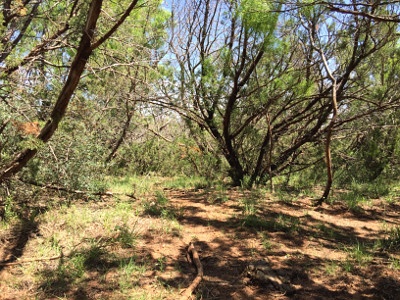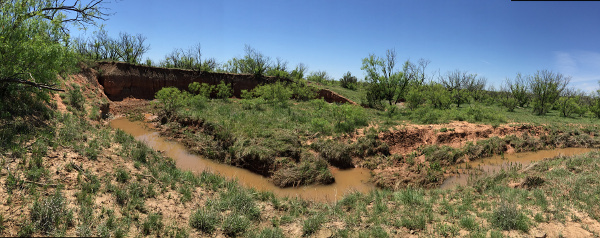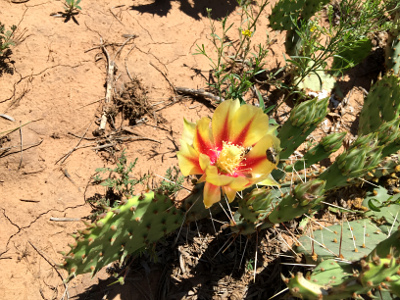Hunting from a blind simply isn’t for me. Some years ago, my son’s first “hunt” was a turkey hunt from a box blind. There we sat for hours, him beating the Brick Braker game on my Blackberry, me wondering about my sanity. Spot and stalk hog hunting in wheat fields can be a blast, especially when using night vision or thermal after the sun has set. But hogs are smart, and just because you don’t always see them in the open doesn’t mean they aren’t there. Whether you hunt in thick green foliage or find yourself in Mesquite tree forests between wheat fields, you’ll find the following tips and tricks on target for stalk hunting through the brush.
 How to stalk wild hogs is a topic that comes up often. On the one hand, it’s pretty straight forward. Just hit their hideouts and be quick on the trigger and accurate when you stumble upon them. I’ve done this effectively on several occasions in West Texas. But to be successful, there’s a bit more to it.
How to stalk wild hogs is a topic that comes up often. On the one hand, it’s pretty straight forward. Just hit their hideouts and be quick on the trigger and accurate when you stumble upon them. I’ve done this effectively on several occasions in West Texas. But to be successful, there’s a bit more to it.
Gun Selection
In my experience, smaller and lighter guns win when stalking wild hogs. On one hunt I was carrying an FN PS90, a super lightweight, super compact bullpup rifle with a 50 round magazine. I know, plenty of people think hog hunting with the 5.7 is a dumb idea, but I have video to prove the 5.7 round of Elite Ammo was thoroughly effective on a 180 pound hog. We’ll gloss over caliber discussion at this point to focus on weight: when you’re carrying a gun for hours, weight matters. A typical AR-10 in .308 isn’t something I’d want to carry through the brush or vegetation. With a sling, however, the new seven pound G2 DPMS Compact Hunter I shot at Gunsite Academy would be a great choice. I did do one stalk with a tactical Remington Versa Max, but generally speaking I’d prefer a semi-auto magazine fed carbine length or shorter gun.
On a recent hunt with Remington Defense I went out stalking through some thorny terrain with a full auto 300 Blackout AR-15. Temperatures were approaching ninety degrees with a rare amount of humidity in the air. The stalk was planned to take two hours, but ended up taking closer to four. I never noticed the weight of the average built rifle.
Due Diligence
When stalking hogs, it pays to let someone know your plans in advance. Sure you have your smartphone, but what if you don’t have coverage? Or your battery dies? Or you trip and fall drowning or breaking your phone? Our outfitters on the Remington hunt knew within a square mile or less where we’d be, but we’re talking about 640 acres in that section alone with much of it thick with thorny green Mesquite trees. Knowing I could end up without contact, I sent the planned details of my hunt including where I’d be, estimated time in and out, who I was with and relevant gear list to my wife and brother as I started the stalk. Be sure to check in when done or you might have some worried folks!

Prepare for the Expected
On that recent trip to Spike Box Ranch to try out Remington Defense military guns on hunts, I prepared for expected snake encounters. I don’t always wear snake boots, but given the terrain and heat, my Danners were mandatory. I wore my PIG gloves from SKD Tactical, one of the best gifts my brother has ever given me. They weren’t mandatory either, but I appreciated the minimal level of protection they provided while still allowing me to use my phone’s touch screen. I had a full magazine of super sonic Remington 300 Blackout, and another on my belt.
Prepare for the Unexpected
Dehydration and heat go together. I put a full bottle of water in my cargo pocket. I figured that’d be plenty for a couple of hour hog stalk weaving, ducking and even crawling through the prickly vegetation. And it was. But by hour four when I actually wrapped up my stalk I was really thirsty and not feeling so great. I’d traveled further than planned, longer than planned. Having reached a designated landmark before some of the others stalking somewhere near me, I decided to press on to the far boundary. It seemed like a good idea at the time…
 Location, Location, Location
Location, Location, Location
The reason I knew the southern boundary was because I studied an aerial map of the area before heading out. I even took a picture of it with my phone. Combined with my phone’s compass I always had a good idea of where I was. You wouldn’t think you could get turned around in such a small area, but plenty of people have, whether in Texas, Colorado, or any myriad of other places. Planing mitigates that.
Obviously, success would generally include seeing and killing hogs. Stalking on that Spike Box hog hunt with Remington Defense, I came across a number of hogs. First, there was a ghost. Just a flash of brown in a fraction of a second moving fast, moving silently, at 100 yards. No shot there. Next a group of ten or so, cruising along at full speed sixty yards from my location. I let off a volley, but in the thick foliage I only had a few places between trees to connect and failed. There was a fleeting encounter with one of the biggest hogs I’ve seen, but he managed an escape as well. In his case I simply wasn’t quick enough. It must be time for some more training at the Sportsman Shooting Center cinema shooting range in Dallas.
We’ll soon have a forum running where you can share your tips and trick for stalking wild hogs. Be sure to subscribe to our newsletter to be alerted when that happens.



I can relate to your “Hog Stalking”… Still-Hunting Whitetail Deer (in NY’s Adirondacks) was my favorite way to hunt those ‘seasoned’ old bucks whose senses of smell, hearing, and vision are way more acute than ours making them very difficult to hunt. There were times it took me 2-3hrs to close in a 100yds to get a shot. I think it is the most challenging, rewarding and ethical way to hunt. Time and infirmity have ended my hunting but I have the memories.
Sounds exciting, Pat! Thanks for reading and commenting here. Hope you can still get out from time to time!
I see a lot of info on your site about using firearms. What info do you have about hunting’s hogs with a bow?
Well, you’re right! Maybe something we can work on.